By: Joseph Crane
Over the past few decades, “chaos theory” and “complexity theory” have emerged as new scientific models for understanding chaotic and/or complex systems. Chaos theory has grown out of physics and mathematics. Complexity theory has developed mainly from studying biological and human systems. These theories share a natural alignment with the spirit and practice of astrology, more so than other attempts to use astrology with the concepts of modern science. The current configuration of Uranus and Pluto makes this an auspicious time to discuss chaos and complexity theory with astrologers.
Among the many resources available to the general reader on the subjects, I am particularly indebted to Bernadette Brady’s Astrology: A Place in Chaos (2006).[1] She has helped open up chaos theory to astrologers and has inspired much of the study I have done in this area. Although my ideas differ from hers in some ways, I suggest that anybody who wishes to study this material further begins with Ms. Brady’s book – but don’t stop there. At the end of this article I include additional resources for the interested reader.
This essay is divided into three parts. First, we look at chaos from our own understanding and experience and briefly trace its history in cosmology and philosophy. The second part provides a brief history of the development of modern science’s chaos theory, some of its methods and findings, and possible applications to astrology. Science’s chaos theory examines disorder, or randomness while seeking to find its underlying hidden structures – as we do as astrologers. Finally, we will look briefly at the idea of complexity, which provides an understanding of states that move toward chaos or move from the more chaotic to the more orderly.
The title of this article is taken from a book by the Buddhist teacher, Chögyam Trungpa, entitled Orderly Chaos (1991).[2] Chögyam Trungpa tells us that the mandala principle (a view of the structure of the world and life around us) is orderly chaos: it comes in a pattern, but working with this pattern is chaotic, confusing. As astrologers, we are along a similar path, applying the ordered world of astrological delineation to the seemingly random events in the lives of our clients.
The Word “Chaos” and Its Modern Use
Google’s NGram Viewer tracks the frequency of words in publications in English since the 1800s. Applying this graph to “chaos” and “chaotic” shows how common these words are in our language at various points in time.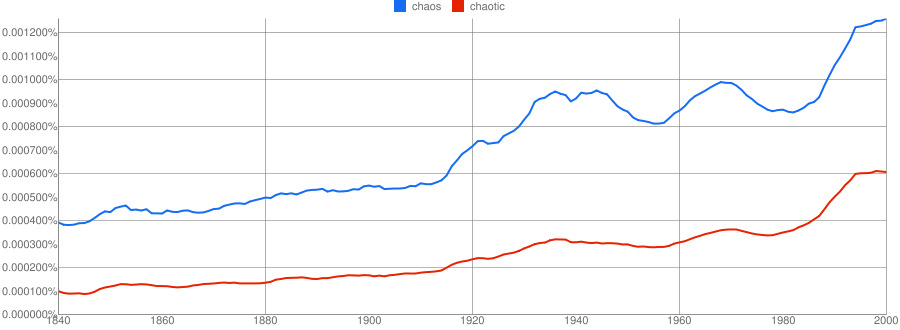
Google NGram View of the usage of the words “Chaos” and “Chaotic” in publications since 1840.
Their frequency of use grew during the more difficult times of the last century but increased even more within the past twenty years. Interestingly, their usage increased dramatically in the mid-1960s at the peak of the Uranus/Pluto conjunction and the world events signaled by that conjunction.
What is the meaning of “chaos” and “chaotic” in our daily lives? It often refers to a flurry of disorganized activity around us when everything seems to be coming at us at once. We lose our sense of centrality and the world becomes temporarily disordered. Chaos is disorienting and overwhelming, requiring a great amount of energy from us.
But some chaos can be good. In a work of music or art, a moment of chaos can have a spontaneous feel to it, and we enjoy the chaos of five-year-old children engaged in boisterous activity – until we have to get them to sit still. Even if we sometimes experience chaos in our lives as unpleasant, at other times we long for things to get interesting once again. Chaos brings many people to their astrologers. Our clients may experience their current life situations as overwhelming and unpleasant, or they may feel stuck and long to have things stirred up. Much of our work as consulting astrologers is to help people navigate life’s movements toward chaos or the re-emergence of a new order from chaos.
Chaos as Ante-Archetype
The concept of “chaos” has a long and interesting history, beginning with stories of the world’s creation. In many traditions, the world spontaneously arose from chaos in stages. In the Book of Genesis, creation also happens that way, but under the direction of a conscious, intentional Creator.
An earlier Babylonian tale begins with Tiamat, the “mother of chaos”: feminine, maternal, and the dark primeval ocean. Her husband Apsu was the freshwater. They gave rise to generations of gods whose exuberant activity irritated the steady but inert Tiamat and Apsu. Then things got even worse when Apsu was killed and the situation descended into warfare. The god-children had brought chaos to their beleaguered parents.
The leader of the upstart gods was the princely, heroic Marduk, who is the planet Jupiter in Babylonian astrology. Moving against his primal ancestor, Marduk caused storms and havoc, and he eventually shot an arrow through Tiamat, killing her. He then cut up her dead body, and from her remains formed our world. Relief sculptures of this great battle cast Tiamat as monstrous or amphibian. The result of this destructive chaos is the ordered, hierarchical universe governed by Marduk, yet formed from the body of Tiamat, the deity who represents nature as originally vast but inert and unformed.
The motif of chaos and creation as a generational conflict is echoed in Hesiod, a Greek poet of the 7th century CE. According to Hesiod, Chaos is not a god but a dark void from which the first parts of creation come forth: Gaia, Tartarus of the underground Earth, and Eros. Then day arises, followed by the first generations of Titans and later the Olympian Gods. This sequence culminated in Zeus’s triumph over his father, the titan Chronos. Again, we have creation happening in steps from formlessness.
Ovid, the Roman poet writing seven centuries after Hesiod, tells us that originally there was just Chaos, described as “a shapeless, unwrought mass of inert bulk/and nothing more, with the discordant seeds/of disconnected elements all heaped/together in anarchic disarray.” (Metamorphosis: Book 1:10-13)[3] Everything is a jumble, a hurly-burly that makes no sense. Ovid’s rendition of chaos seems closest to the word that has come down to us today.
In the oriental traditions, chaos is cast differently. In the Tao Te Ching, chaos is the ongoing activity of creation: things are brought about darkly and chaotically and unfathomably. This parallels the concept of the Feminine Principle from the Indo- Tibetan traditions: the ongoing background of space and emptiness that continually gives rise to our world.
This concept of chaos as primordial parallels our modern psychological concept of the “fertile void” – the open-ended psychic space that gives rise to new understanding and creative solutions. Is this the same “chaos” that we experience in our lives? I think not.
In its original formulations, chaos is previous to and more basic than, ordered time and the creation of the stars and planets with our ordered universe. Thus, we are before astrology – no stars or planets can symbolically represent this background to the created world. This is not the “chaos” of everyday discourse, but rather ante-archetype (perhaps anti-archetype).
Chaos as a Value
In the literature of ancient Greece there was an important role for chaos. In the Iliad, Homer exalted the carnage and glory of warfare. He presented the heroic (though short and violent) life of Achilles as being superior to a long but ordinary life. For the later poet Sophocles, life itself is not subject to the ordering activity of reason but always veers toward the chaotic. We need to accept the fact that the world does not make sense, yet we can act within that world with dignity and heroism.
This contrasts with Greco-Roman philosophy and psychology that emphasized using our intelligence to control the inherent disorder of our bodily senses and passions. Our rational faculty is like the chariot driver driving the horses of our unruly appetites and emotions. A successful outcome is a good person and a good citizen. This also has a metaphysical dimension: the material world requires in-forming activity from above and beyond to become intelligible. This flourished in Neoplatonic traditions of late antiquity.
Neoplatonism profoundly influenced the medieval Christian doctrine, but there were three divergences that are important here. Theological doctrines of the Incarnation, the Creation of the Material World, and the Resurrection of the Body legitimized a new interest in the natural material world. This helped give rise to Western science, beginning in the 1200s with the rediscovery of Aristotle. The goal became to discover the hidden order of the world: to find the footprints of an ordering God within the disorder of the material world. A couple of hundred years later, the theological doctrines fell away and the “scientific revolution” could begin.
![]()
We skip ahead a few centuries and discuss the life of a modern prophet of chaos, someone who loved Homer and Sophocles and considered most ancient and medieval philosophy to be decadent. This is the nineteenth-century European philosopher Friedrich Nietzsche. His writings called into question the main principles of Christian ethics and modern democracy and considered his contemporary culture to be sick. In his personal life, Nietzsche was a lonely and emotionally tortured man. Today he is considered one of the most interesting modern philosophers.
In The Birth of Tragedy, which Nietzsche wrote in his twenties, he posited an opposition of the Apollonian and Dionysian, an opposition between a longing for order and a longing for disorder. The Apollonian was represented by nostalgia for form and by the visual arts. The Dionysian was allied with music, for music stimulates us to sing and dance and get carried away. The Dionysian ideal was to give rise to the chaos within ourselves. Nietzsche tended toward the transformative qualities of chaos:
“You must be ready to burn yourself in your own flame: how could you become new, if you had not first become ashes?”
Friedrich Nietzsche’s chart has some eye-popping components and a particular emphasis on oppositions that involve Uranus and Pluto.[4]
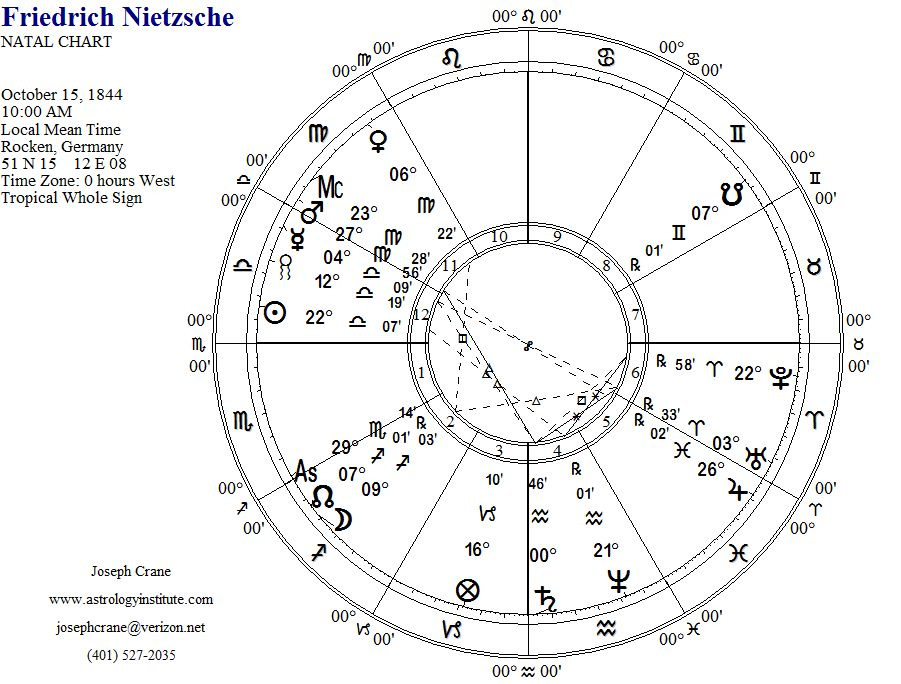
Friedrich Nietzsche’s Natal Chart Using Whole Sign Houses
Nobody could be surprised that Nietzsche had a Scorpio Ascendant. The fiery red planet Mars, governing Scorpio, is in a strong position in the Eleventh House, the ancient place of the “Good Spirit.” This Mars, signifying Nietzsche’s fiery disposition, has a close opposition to a dignified Jupiter that adds a philosophical outlook. Jupiter makes an important contact to Uranus: they are contra-antiscia, symmetrical to the 0° Aries – Libra axis. This placement contributed to making Nietzsche an unusual philosopher, somebody with a bit of the renegade in him. In discussions of Nietzsche’s writings, we read frequent assertions that his life and ideas are “untimely”, ahead of his time.
In this context, we can see more clearly the close opposition from Uranus to Mercury. These two planets figure prominently in the story of the development of the field of chaos.
Nietzsche wedded excellent prose with a desire to be philosophically provocative. Many of Nietzsche’s writings are left open-ended as if he was conversing directly with his reader. “Conventional wisdom” was something to be dismantled and dialogue is how to do that. For this, we can thank the configuration of Mercury opposite Uranus, and Uranus symmetrical to a dignified Jupiter.
This brings us to Nietzsche’s other major opposition: Sun opposite Pluto. Consider his Sun in Libra in the Twelfth House that appears rather weak. Yet this is mitigated by the Lot of Daimon being nearby[5], and the Sun conjunct and co-rising with the fixed star Spica.[6] He was a dynamic and creatively fertile individual in his writings, but not very self-expressive in person. When we factor in the opposition from Pluto, we see somebody who can articulate philosophical principles based on will and power, as well as the creative intensity of the passions.
The oppositions of Mercury with Uranus and Sun with Pluto are both in the cadent Sixth and Twelfth Places. Although Nietzsche’s writings have an abundance of the heroic, and even a defense of life’s cruelties, in person he was reserved, even kind and compassionate.
With such strong placements of Uranus and Pluto in his natal chart, we would expect Nietzsche’s life to be sensitive to their transits. In 1879, he resigned his decade- long post as a professor of philology at Basel University and began a decade of wandering as an independent author. Chaos suddenly intruded in late 1882 when he was cohabitating with his writer friend, Paul Reé, and the young Lou Andreas Salomé, whom Nietzsche had fallen in love with. While transiting Pluto was opposing his Ascendant, his two friends ran off together, leaving Nietzsche alone in despair. Yet a few months later, in January 1883, Nietzsche completed the first part of his Also Sprach Zarathustra in a white heat of productivity while transiting Uranus moved over his Midheaven. During the completion of this masterwork over the next two years, Uranus moved over his Mars and Mercury opposite his Jupiter and Uranus.
Unfortunately, Nietzsche’s life ended in his becoming insane and increasingly physically incapacitated, spending his last ten years in the care of his family. His mental breakdown happened in the early days of 1889 with transiting Uranus making its first pass over his Sun in opposition to Pluto. (Transiting Neptune was also approaching opposition to his Ascendant.)
As we will see later, Nietzsche’s breakdown was an indication of complexity–a radical shift toward chaos that can give rise to a creative response; his breakdown, however, was closer to chaos in a most tragic and irreversible form.
Closer to our lifetimes was Chögyam Trungpa, who fled Tibet and taught Buddhism in the West. Like Nietzsche, Trungpa also espoused a philosophy we could call chaotic, taking delight in disorder as a great way to wake people up.
Very beautiful situations have developed using chaos as part of the enlightened approach. There is chaos of all kinds developing all the time: psychological dis- order, social dis-order, metaphysical dis-order, what have you, constantly happening. If you are trying to stop those situations, you are looking for external means of liberating yourself, another answer. But if we are able to look into the basic situation, then chaos is the inspiration, confusion is the inspiration.[7]
Nietzsche’s and Chögyam Trungpa’s views are also reflected within different schools of psychotherapy in the twentieth century that has strongly influenced current astrological counseling. From this glimpse of chaos, we now go to the “hard sciences” to continue the story.
Chaos as Scientific Study
I will focus on three occasions that help us understand the new science of chaos: the non-solution to the three-body debate that gave us the first glimpse of weird order behind disorder; the discovery of Sensitive Dependency to Initial Conditions (“the Butterfly Effect”) and “strange attractors”; and the research of paths from order to chaos and the discovery of self-similarity and scale invariance.
We begin with an ideal of all the physical sciences: accurate prediction. In a dynamic system using Newtonian physics, if you knew all the factors involved and could apply those fixed laws that are relevant to the interaction, you could predict future conditions accurately. From this point of view, the enterprise of science aims to curb the unpredictable nature of future time.
The physics of Isaac Newton and the “age of enlightenment” achieved much, but only up to a point, and from the beginning, there was a worm in the apple. Although its crowning success was in predicting the location and movements of planets around the Sun, they could not predict the location and movement of three planetary bodies whose gravitational forces influenced each other.
In the late 1800s there was a contest to award the scientist who could come closest to solving the three-body problem. The young French physicist, Jules Henri Poincaré, one of the greatest scientists of his time, decided to tackle this difficulty.
To find a solution, Poincaré devised a concept called “state space” and an instrument later called the “Poincaré map” wherein all the possible states of a system are displayed as a discrete shape. He conjectured that by placing all the information on one graph, patterns previously undetected could be discerned. He was making good progress, but then he discovered he had made a mistake. Redoing his computations, he came up with a startling result: a curved pattern formed by the permutations of three bodies influencing one another. A pair of curves looped back on themselves, crossing to form an infinity of intersections. No two curves could ever cross themselves, but they would cross the web an infinite number of times.
Here we have an example of orderly chaos: finding qualities, characteristics, and rules, but not the anticipated coherent pattern. Poincaré determined that the planets’ changing positions and velocities could not be calculated accurately. He found this simple interaction between three planets to have unpredictable characteristics. There was a pattern inherent within, but none that he could understand.
(There is an important difference between the scientific study “chaos” and quantum physics and Heisenberg’s principle of indeterminacy. Here we are working with a fully deterministic system, whereby present conditions give rise to future conditions. Instead, quantum theory uses indices of probability.)
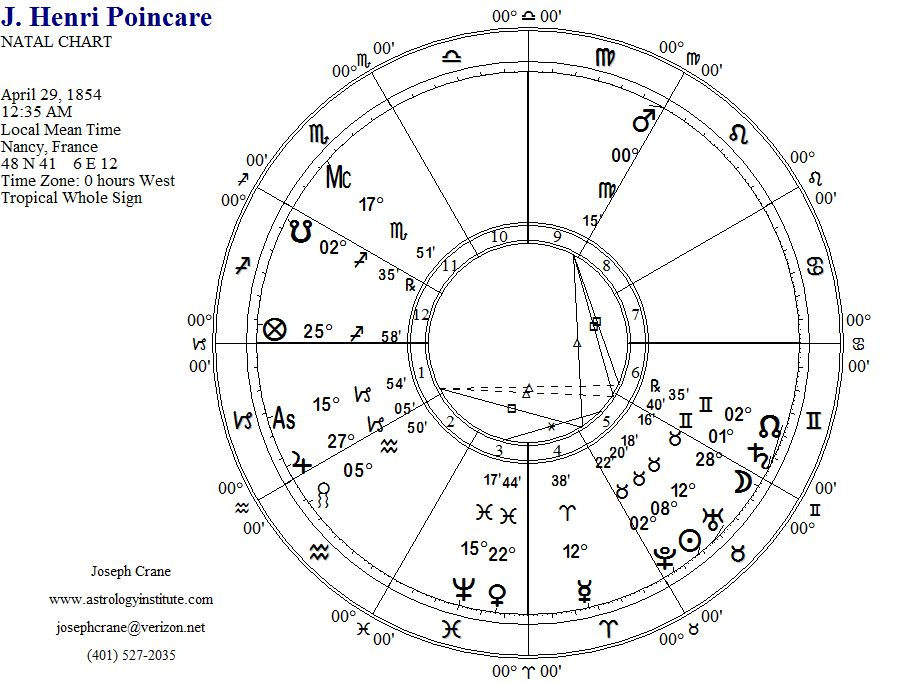
Poincaré’s Natal Chart Using Whole Sign Houses
Here is Poincaré’s natal chart.[8] We first notice many planets in the earth element but with Mercury particularly strong, angular in Aries and oriental. Mercury is also the midpoint of Sun and Neptune. Poincaré was a plodding person who could stick to one thing well, yet he had a wiry and supple mind.
Once again, we find Uranus and Pluto to be prominent. We first notice the Sun applying towards Uranus, but then we see that the Sun is at the Uranus/Pluto midpoint. Poincaré was a pioneering physicist and mathematician who helped develop the new field of topology: the mathematical study of strange forms such as the Mobius strip.
In early 1887, the year he had completed his project and won the scientific prize, transiting Uranus was opposing his natal Mercury. In the best expression of this transit, Poincaré had produced a wonderful feat of intellectual imagination and thereby established the methodology and outcome of scientific chaos.
Yet he and the world of science moved on from his odd “solution” to the three-body problem. It wasn’t until the early 1960’s that the science of chaos picked up again. It resumed through an investigation into a different chaotic system – the weather. Here we meet Ed Lorenz, a mathematician who became a meteorologist and devoted himself to finding a mathematical means to predict the weather. Lorenz devised an elaborate set of equations to model the weather, and with a room filled up with the early computers, he got to work. On one famous evening, he tried to short-cut the data entry process for the start-up conditions and entered rounded off values while re-running a particular model. He rounded his numbers to three decimal places whereas the original model had run with numbers to 6 decimal places. When he returned, he discovered that this small difference made for vastly different weather!
Most scientists might have blamed the problem on bad equipment or faulty inputting (both checked out fine), or attributed the result to having had a tough day, but Lorenz investigated further. Later this phenomenon would be called “Sensitive Dependence on Initial Conditions” (SDIC). This shows the effect of our weather system as nonlinear: a small change can give rise to disproportionately large effects. This turns out to be the case with all interactive systems.
Lorenz’s discoveries and his first publications occurred before the famous Uranus-Pluto conjunction of the mid-60s, yet ten years afterward SDIC became known as “the Butterfly Effect” to the scientific community and in the popular imagination.
Does a natal astrology chart also exhibit Sensitive Dependence of Initial Conditions? Not in the same way as Lorenz’s “Butterfly Effect.” Changing an Ascendant from 29° Scorpio to 00° Sagittarius would have helped Friedrich Nietzsche be a more socially and emotionally secure person, but this would have been the case from birth. Strictly speaking, the “Butterfly Effect” displays increasing divergences over time. It is similar to the 1998 movie “Sliding Doors” where a woman missing the subway or not would have consequences that increasingly diverged throughout the movie.
Lorenz moved from complex weather equations to simpler ones using convection: the patterns of water rising and falling from a heated surface below and a cooler surface above. This is also illustrated with moving water wheels. As the wheel fills with water, the wheel will stay still, or oscillation will occur periodically or haphazardly, depending on the amount of tamping of the wheel’s motion. (Do a search on YouTube for “Lorenz Water Wheel” for a video demonstration.) Our interest here is in the haphazard back-and-forth movements of the water wheel.
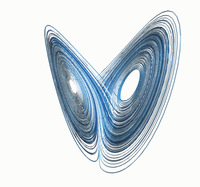 Lorenz found that the seemingly random movements of the wheel did settle into a form, but what a weird form it was! It was three-dimensional, non-returning and a-periodic. This became known as the “Lorenz Attractor”, one of many such shapes that were later called strange attractors. (His definitely looks like a butterfly’s wings.) A strange attractor is different from a point attractor or basin, where things converge at one point or a periodic attractor that resolves into a regular oscillation. Because the system is a- periodic and the foci are irregular, this attractor certainly qualifies as “strange”.
Lorenz found that the seemingly random movements of the wheel did settle into a form, but what a weird form it was! It was three-dimensional, non-returning and a-periodic. This became known as the “Lorenz Attractor”, one of many such shapes that were later called strange attractors. (His definitely looks like a butterfly’s wings.) A strange attractor is different from a point attractor or basin, where things converge at one point or a periodic attractor that resolves into a regular oscillation. Because the system is a- periodic and the foci are irregular, this attractor certainly qualifies as “strange”.
All three kinds of attractors are found in astrology. The stars, planets, and angles move around a fixed point that is the Earth in a geocentric chart, or the Sun in a heliocentric chart. Additionally, the planets are periodically “attracted” to its conjunctions with the Sun and other planets. This is because the positions of the angles and planets are deterministic and also linear.
According to the art of astrology, the always-changing and never-repeating configurations of the skies give rise to the patterned but unpredictable circumstances in our lives. These circumstances may have their own repeating situations, coincidences, and omen-like occurrences with hidden meanings.[9] Astrology gives a conceptual framework for this to occur. The applications of astrology help us understand these occasions – they provide context. Although the configurations of the sky are linear, we use them as strange attractors in their ability to signify people and events on Earth.
Let’s take a brief look at Lorenz’s natal chart. Unfortunately, we only have a date of birth. Although it appears that Lorenz has a close Moon-Pluto conjunction, this is not trustworthy because of the unknown birth time.
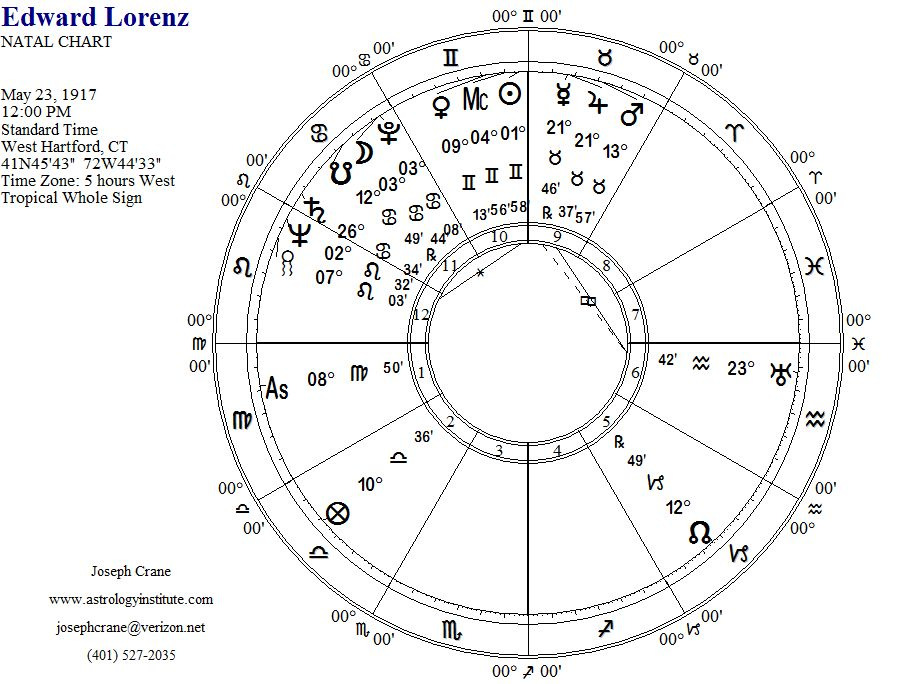
Natal Chart for Edward Lorenz using Whole Sign Houses (Note: Birth time is unknown)
Lorenz’s Sun in Gemini sextile to Neptune qualifies him as a bright and unusually imaginative person. As with Poincaré, Uranus figures prominently: it is in close applying square to both Mercury and Jupiter in Taurus. We see the doggedness of the sign Taurus and the brilliance and eccentricity associated with Uranus. During the time of his research into the chaotic nature of weather prediction, unsurprisingly, transiting Uranus was in opposition to his natal Mercury; his initial article was published in 1963 when transiting Uranus was in opposition to his natal Sun. Lorenz’s trailblazing work was practically unnoticed when it was first published in the 1960s. Today he is considered a pioneer of the study of chaos.
![]()
Our next development takes us into systems and patterns that reveal themselves on the way into chaos. The foremost name associated with this development is Robert May, a theoretical biologist working in the mid-1970s.
At that time May was working with the mathematics of insect population growth. This is also an example of a nonlinear system of interacting components: a growing population will compete for limited resources, variable predator populations, etc. As a result, the population will decrease and increase again, and so on. According to the mathematical model used, if the growth rate is too small the species dies out; if the growth rate is a little higher, the population resolves into a continuous oscillation; larger rates of growth, however, result in population swings that are irregular and seemingly random.
The diagram below shows the results of increases of population growth from what’s called a “logistic map.” It gives a different version of the “state space” discussed previously. The vertical “x” stands for the population; the “r” horizontal axis is the rate of growth. The map begins simply and then things start to get weird.
 The single line to the left (rate of growth (r) =2.4 to about 3.0) is an example of a point attractor – there is steady population growth. We first see bifurcations into two paths at r= 3.0 to about 3.45. Here, the population is oscillating between a high and low population level. This would be a periodic attractor if they lead to a regular oscillation but they do not. Instead, they lead to another bifurcation into four values (two different highs and two different lows) and then another one into eight and this can continue. Then we reach the “accumulation point”, an amount a shade less than r=3.6, where things seem to go out of control.
The single line to the left (rate of growth (r) =2.4 to about 3.0) is an example of a point attractor – there is steady population growth. We first see bifurcations into two paths at r= 3.0 to about 3.45. Here, the population is oscillating between a high and low population level. This would be a periodic attractor if they lead to a regular oscillation but they do not. Instead, they lead to another bifurcation into four values (two different highs and two different lows) and then another one into eight and this can continue. Then we reach the “accumulation point”, an amount a shade less than r=3.6, where things seem to go out of control.
However, when we look to the right of the accumulation point, we see a darkened area but one not without some form. If we could look closer at the white areas, we would find further bifurcations that look quite like the visible ones. This is not the mess that it appears to be; instead, it obeys principles of self-similarity – we get the same general shape of a horseshoe, though they are not quite the same. They are not quantitative identities but quantitative similarities.
There is another strange factor to the shape: its rate of decrease of the horseshoe shapes that are the bifurcations. A mathematician named Mitchell Feigenbaum discovered that the rate of decrease horizontally, and the difference in values horizontally between “period doublings” was 4.6692016091. These same numbers would show up in other chaotic systems, from iterating a function on a hand calculator to chemical and physical systems of values or qualities that interact with each other. The scientific study of chaos leads not to an affirmation of randomness, but rather to the discovery of a kind of order that is very hard for us to comprehend. Can anybody find a rationale for Feigenbaum’s number?
In our lives, do we encounter bifurcations and period doublings? When do we not encounter them? Any moment in which we are not acting out of habit we meet bifurcations. Indeed, when we examine our responses to specific situations in our lives, we always encounter a moment to go one way or the other. Tomorrow’s route is based on the one we take today, and so bifurcations and period doublings lead to unpredictable but deterministic outcomes. Perhaps this is what free will is.
As astrologers working with clients, we can spot times of new possibilities for the client, but not know what direction he or she will choose. From knowing astrological symbolism and having some understanding of the circumstances and issues our client is facing, we can make some good conjectures, but the outcomes are unpredictable. The client may be influenced by our advice, but the actions always belong to him or her.
In astrology do we encounter self-similarity? We certainly encounter self- similarity in time. Consider the range of sensitive points in a natal chart: every day the Ascendant and Midheaven transit the same sensitive points; each month the Moon and each year the Sun will transit these points; Saturn will take almost thirty years. This is also the case with directions, many ancient chronocrator systems profections of 30° a year, and the movement of the age point according to the Huber method of progression.[10]
![]()
Moving on to the next development in Chaos Theory, we will now look at fractals. The person most associated with this is Benoit Mandelbrot, who coined the term from the Latin word for “irregular”. It turns out that fractals are far more prevalent in nature than are the standard geometrical shapes. Their presence ranges from the twisting shapes of many jagged shorelines, to the intricate surfaces of our lungs and brains, to the distribution to leaves on a tree, to the contours of geological formations. They also are found in various art forms. Fractals obey principles of self-similarity and scale invariance – the same shapes appear regardless of larger or smaller scales.
Certain mathematical equations that use “complex” numbers (merging real and imaginary numbers) can give rise to stunning forms. The best known is the “Mandelbrot set” that contains forms that continue infinitely. I trust that interested readers will pursue the story further on their own. An animation of the Mandelbrot set is a great place to begin and is easily found on the internet.
To summarize, the study of chaos is the study of systems of apparent chaos. “Chaotic” phenomena may be non-periodic and unpredictable, but they are not random. Instead, they show evidence of peculiar kinds of order. There are many other systems that also appear random that are not yet understood by the science of chaos. For example, we cannot quite determine highly complex interactive systems like the general economy, although we can perceive patterns of self-similarity and scale invariance in the stock market. Social trends among highly interactive beings like ourselves are at the high end of seeming randomness.
As a logos, astrology is not about chaos but order. Certainly the sky and earth we look at as astrologers have an order to it. Otherwise, we couldn’t predict planets’ positions in the sky and would have nothing to base our predictions upon. This is the case whether we use earth maps or star maps, geocentric or heliocentric positions, or a Hellenistic or Vedic chart. Yet its relationship with chaos and complexity gives astrology its relevance and importance in peoples’ lives. People seek the advice of astrologers (among others), not because their lives proceed randomly, but because there is unknown order behind these seemingly random happenings of life.
Uranus and Pluto, Chaos and Complexity
Now we engage the so-called “soft sciences,” particularly sociology, anthropology, and psychology. How do systems – individuals and families, species of living things, cultures and fashions – change? All these are dynamic, nonlinear systems made of interacting components. Here, instead of being called “Chaos Theory”, it is called “Complexity Theory.”
What is Complexity? It is the transitional stage between chaos and order and back again. When the direction is from order on its way to chaos, this a path of entropy. Closed systems that do not interact well with their environments may move into entropy. If so, the loss of internal energy and the growing influence of outside forces will eventually overwhelm a system’s capacity to adapt and maintain its form.
Complexity also occurs in relatively chaotic systems on their way toward order as self-organization occurs. There is a strong tendency in nature for different units to coalesce to create one larger unit, whether it’s the development of more complex life forms in evolution, the unconscious synchronization of rhythms between people, or the tendency of people, families, and cultures to create new forms out of disarray. The astrologer’s job is to help identify and support this process as it occurs.
As we know from our own lives and those of others, we do not have the ability to endure chaos for very long. If chaos can grow into complexity, however, new creative “self-organizing” possibilities occur.
Chaos is not the “fertile void” after all. Instead, the richness of new possibilities is the activity of complexity–the movement from fixed order toward chaos and then back toward order. This provides us with our greatest creative possibilities.
From an astrological viewpoint, this movement that results in either entropy or self-organization is correlated to our interpretations of Pluto and Uranus: Uranus because its nature is turbulence; Pluto because it undermines fixed patterns. (Neptune may compromise the core structure from the inside, as we’ve seen with Friedrich Nietzsche’s breakdown.)
From the natal placements of Uranus and Pluto, we may see what areas of our lives are most likely to move to and from chaos; their transits show when movements toward chaos will happen. They may signal those times when our lives can be shaken up by external events or by our own subjective choices.
Eventually, nature’s tendencies toward synchronization and self-organization take over and new creative possibilities emerge. Neither transiting Uranus nor Pluto can govern these possibilities: when these planets have finished their work of transition, the newer structures of life take over.
CASE STUDY
I end with Uranus and Pluto and chaos in the life of one of my clients. She has been married for ten years and has two children, yet is determined that her marriage end. At this time her husband is resisting and has refused to leave their house. It is likely that the result will be a contested divorce suit and a bitter custody battle, especially since she wants to live overseas with her children. She may also decide to stay with him after all. Her chart and transits clearly depict her difficult situation
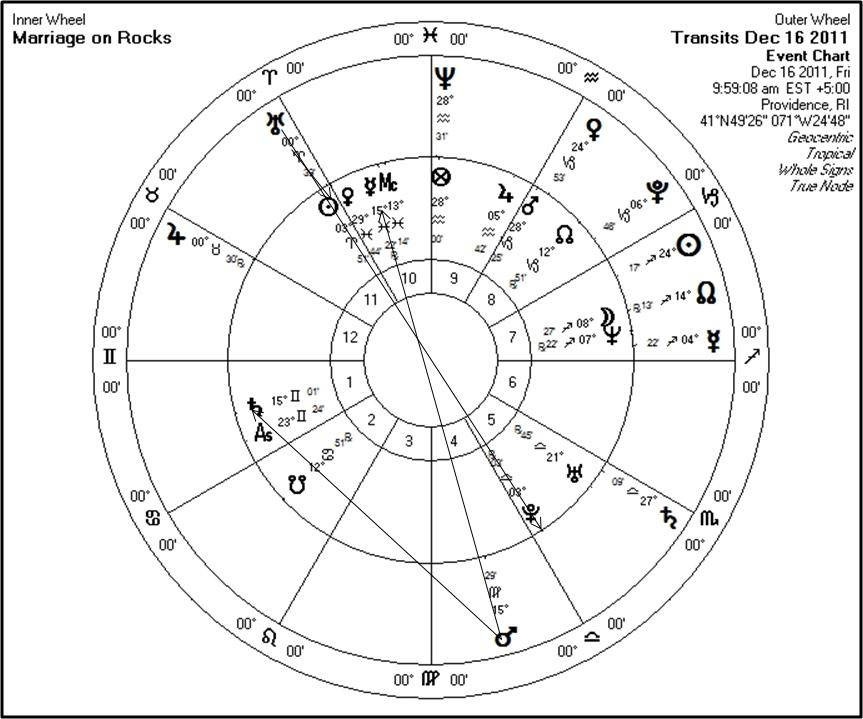
“Marriage on the Rocks” Chart using Whole Signs
My client’s natal chart displays a strong Sun opposite Pluto with its implications of power struggles in relationships. This is made more complicated by her conservative Saturn in the First House and enabling Neptune-Moon conjunction in the Seventh. Also, Mercury in Pisces in the Tenth, although strongly positioned as ruler of her Ascendant, may show a tendency to minimize difficulties or put off dealing with them – until Mercury’s square from Saturn kicks in. At this time, however, she has chosen to face all her difficulties at once.
Pluto began her marital drama in 2009 when, from Capricorn, it formed a square to Sun in Aries and Pluto in Libra. This began a process of increasing discontent. In the period from May through September 2011, with Uranus dwelling on her natal Sun and opposing Pluto, my client resolved to end the marriage and began the separation and divorce process. At the time of this writing (December 2011), Mars has entered the sign Virgo where it will remain for the entire first half of 2012. Mars is in her Fourth House of home and family and is right now transiting Saturn, Mercury, and her Midheaven.
Of course, she wants to know what is going to happen! We can look at the timing of these transits as peaks and valleys in the process. We also know that she has begun a course of events – a temporary descent toward chaos – that she cannot undo and that will have ramifications for her own life as well as all her family members. Even if she stays married to her husband, it would be a very different marriage that would need to emerge.
The future course of events will be dictated by her own actions and those of her husband, their respective lawyers, their children, and the legal system. Although she has initiated these events, she cannot control their outcome. Specific outcomes are based on shifting contexts. An astrologer cannot predict exactly who will do what, any more than the physicist can figure out the exact locations and velocities of three planets that influence each other’s gravitational fields.
However, based on the relevant astrological symbolism, knowing the client, and an application of intuition, the astrologer may come up with some pretty good ideas. Yet they will be only approximations. In this case, I do know that a week after Mars leaves Virgo and her Fourth House, she has a progressed New Moon. Things are indeed “chaotic” in the ordinary use of the word, but there is order within the maelstrom from which new order and a new life will emerge.
Bibliograhy
Brady, Bernadette. Astrology: A Place in Chaos (2006) Bournemouth,UK: The Wessex Astrologer
Bütz, Michael. Chaos and Complexity: Implications for Psychological Theory and Practice (1997) Washington DC: Taylor & Francis
Gleick, James. Chaos: Making a New Science (1987) New York: Viking
Smith, Leonard. Chaos: A Very Short Introduction (2007) New York: Oxford University Press
Strogatz, Steven. Chaos (2008) Chantilly, Va. The Teaching Company (24 lectures and Course Guidebook)
-
Notes
[1] Bournemouth, UK: Wessex Astrologer
- [2] From Shambhala Publications. Orderly Chaos also appears in The Collected Works of Chögyam Trungpa, Vol. 6, p. 301-425 Boston Ma: Shambhala Publications, 2004
- [3] Translation by Charles Martin. (2004) New York, W.W.Norton
- [4] Chart reliability is “B” according to Astrodatabank: derived from biographical sources.
- [5] Otherwise known as the “Lot of Spirit”, this Lot is symmetrical to the Ascendant of the Lot of Fortune. If the Lot of Fortune represents outer circumstances and circumstances we cannot directly control, the Lot of Daimon signifies areas of deliberation and conscious choice.
- [6] Spica is the largest star of the constellation Virgo and is associated with good fortune, fertility and creativity. This is one of the most positive stars used by astrologers.
- [7] Ocean of Dharma: The Everyday Wisdom of Chögyam Trungpa. #12. (2008)Boston, Ma. Shambhala Publications
- [8] Chart reliability is “AA”: from birth records.
- [9] Brady (2006). 65-67
- [10] http://www.astrologicalpsychology.org/articleageprogression.html Accessed Dec. 12, 2011.



